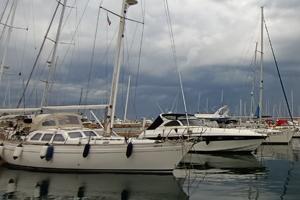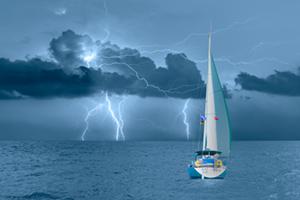Prepare your boat for the next storm

Boats are sturdy modes of transportation, but even the most seasoned boater with the sturdiest watercraft must keep one eye on weather forecasts to avoid serious damage.
When strong storms are in your forecast – especially tropical storms and hurricanes – you need to have a plan.
Consider some tips to help minimize the potential of damage to your boat:
Watch the weather. Check in often to see what storms might be brewing. The National Oceanic and Atmospheric Administration gives real time updates and can track storms coming to an ocean near you.
Land, ho! Have a plan to bring your boat out of the water and stored in a safe location. If your boat is docked at a marina, communicate well ahead of any storms to coordinate how to safely and timely haul it away from dangerous waters. Talk to your independent agent about hurricane haul out coverage. This protection offered by The Hanover provides coverage to haul out and return your boat to water in the event of a hurricane.
Lower fetch for moor success. If hauling your boat out of the water is not an option, knowing where to park your boat can be crucial. When mooring your boat, know what location sees the least amount of fetch such as canals and hurricane holes, which are narrow inlets and coves surrounded by structures such as trees that can block the wind.
Secure that trailer. Place concrete blocks under the frame, take some air out of the tires, insert the plug and then fill it halfway with water. Lastly, strap the boat to the trailer.
Reduce windage concerns. Strip the boat of all canvas anywhere on board, as these may be damaged by high winds. When the wind gets above 60 knots, it can exploit small weaknesses in the canvas and cause widespread damage.
Anchors away. If your boat is still in the water, consider setting multiple anchors. Use two or three anchors tactically positioned – or consider doubling or tripling your anchors’ attachment points to heavy, fixed points on land.
Change out old dock lines. Be proactive about replacing older dock lines. Consider installing chafing gear or adding mooring compensators or snubbers to reduce the tension these lines face during storms.
Keep those extras from sailing away. Secure all portions of your boat from taking on water, but also consider taking all items not securely screwed down, such as fishing rods, flags, grills and life-rings.
Bring valuables ashore. Remove any valuables, including bedding, fishing equipment and any important boating documents (i.e. your registration) on land until the storm passes. Take out any electronic equipment that can be removed, in case of shorting out if water gets in your boat.
Talk to an independent agent about how The Hanover has coverage options to protect your boat, and help keep it in shipshape condition, as well as savings options when you bundle your coverage with The Hanover.
Sources:
This material is provided for informational purposes only and does not provide any coverage or guarantee loss prevention. The examples in this material are provided as hypothetical and for illustration purposes only. The Hanover Insurance Company and its affiliates and subsidiaries (“The Hanover”) specifically disclaim any warranty or representation that acceptance of any recommendations contained herein will make any premises, or operation safe or in compliance with any law or regulation. By providing this information to you, The Hanover does not assume (and specifically disclaims) any duty, undertaking or responsibility to you. The decision to accept or implement any recommendation(s) or advice contained in this material must be made by you.
LC 2021-214
Related resources
Prepare your boat for the next storm
Boats are sturdy modes of transportation, but even the most seasoned boater with the sturdiest watercraft must keep one eye on weather forecasts to avoid serious damage.
When strong storms are in your forecast – especially tropical storms and hurricanes – you need to have a plan.
Consider some tips to help minimize the potential of damage to your boat:
Watch the weather. Check in often to see what storms might be brewing. The National Oceanic and Atmospheric Administration gives real time updates and can track storms coming to an ocean near you.
Land, ho! Have a plan to bring your boat out of the water and stored in a safe location. If your boat is docked at a marina, communicate well ahead of any storms to coordinate how to safely and timely haul it away from dangerous waters. Talk to your independent agent about hurricane haul out coverage. This protection offered by The Hanover provides coverage to haul out and return your boat to water in the event of a hurricane.
Lower fetch for moor success. If hauling your boat out of the water is not an option, knowing where to park your boat can be crucial. When mooring your boat, know what location sees the least amount of fetch such as canals and hurricane holes, which are narrow inlets and coves surrounded by structures such as trees that can block the wind.
Secure that trailer. Place concrete blocks under the frame, take some air out of the tires, insert the plug and then fill it halfway with water. Lastly, strap the boat to the trailer.
Reduce windage concerns. Strip the boat of all canvas anywhere on board, as these may be damaged by high winds. When the wind gets above 60 knots, it can exploit small weaknesses in the canvas and cause widespread damage.
Anchors away. If your boat is still in the water, consider setting multiple anchors. Use two or three anchors tactically positioned – or consider doubling or tripling your anchors’ attachment points to heavy, fixed points on land.
Change out old dock lines. Be proactive about replacing older dock lines. Consider installing chafing gear or adding mooring compensators or snubbers to reduce the tension these lines face during storms.
Keep those extras from sailing away. Secure all portions of your boat from taking on water, but also consider taking all items not securely screwed down, such as fishing rods, flags, grills and life-rings.
Bring valuables ashore. Remove any valuables, including bedding, fishing equipment and any important boating documents (i.e. your registration) on land until the storm passes. Take out any electronic equipment that can be removed, in case of shorting out if water gets in your boat.
Talk to an independent agent about how The Hanover has coverage options to protect your boat, and help keep it in shipshape condition, as well as savings options when you bundle your coverage with The Hanover.
Sources:
This material is provided for informational purposes only and does not provide any coverage or guarantee loss prevention. The examples in this material are provided as hypothetical and for illustration purposes only. The Hanover Insurance Company and its affiliates and subsidiaries (“The Hanover”) specifically disclaim any warranty or representation that acceptance of any recommendations contained herein will make any premises, or operation safe or in compliance with any law or regulation. By providing this information to you, The Hanover does not assume (and specifically disclaims) any duty, undertaking or responsibility to you. The decision to accept or implement any recommendation(s) or advice contained in this material must be made by you.
LC 2021-214
Related resources
Prepare your boat for the next storm
Boats are sturdy modes of transportation, but even the most seasoned boater with the sturdiest watercraft must keep one eye on weather forecasts to avoid serious damage.
When strong storms are in your forecast – especially tropical storms and hurricanes – you need to have a plan.
Consider some tips to help minimize the potential of damage to your boat:
Watch the weather. Check in often to see what storms might be brewing. The National Oceanic and Atmospheric Administration gives real time updates and can track storms coming to an ocean near you.
Land, ho! Have a plan to bring your boat out of the water and stored in a safe location. If your boat is docked at a marina, communicate well ahead of any storms to coordinate how to safely and timely haul it away from dangerous waters. Talk to your independent agent about hurricane haul out coverage. This protection offered by The Hanover provides coverage to haul out and return your boat to water in the event of a hurricane.
Lower fetch for moor success. If hauling your boat out of the water is not an option, knowing where to park your boat can be crucial. When mooring your boat, know what location sees the least amount of fetch such as canals and hurricane holes, which are narrow inlets and coves surrounded by structures such as trees that can block the wind.
Secure that trailer. Place concrete blocks under the frame, take some air out of the tires, insert the plug and then fill it halfway with water. Lastly, strap the boat to the trailer.
Reduce windage concerns. Strip the boat of all canvas anywhere on board, as these may be damaged by high winds. When the wind gets above 60 knots, it can exploit small weaknesses in the canvas and cause widespread damage.
Anchors away. If your boat is still in the water, consider setting multiple anchors. Use two or three anchors tactically positioned – or consider doubling or tripling your anchors’ attachment points to heavy, fixed points on land.
Change out old dock lines. Be proactive about replacing older dock lines. Consider installing chafing gear or adding mooring compensators or snubbers to reduce the tension these lines face during storms.
Keep those extras from sailing away. Secure all portions of your boat from taking on water, but also consider taking all items not securely screwed down, such as fishing rods, flags, grills and life-rings.
Bring valuables ashore. Remove any valuables, including bedding, fishing equipment and any important boating documents (i.e. your registration) on land until the storm passes. Take out any electronic equipment that can be removed, in case of shorting out if water gets in your boat.
Talk to an independent agent about how The Hanover has coverage options to protect your boat, and help keep it in shipshape condition, as well as savings options when you bundle your coverage with The Hanover.
Sources:
This material is provided for informational purposes only and does not provide any coverage or guarantee loss prevention. The examples in this material are provided as hypothetical and for illustration purposes only. The Hanover Insurance Company and its affiliates and subsidiaries (“The Hanover”) specifically disclaim any warranty or representation that acceptance of any recommendations contained herein will make any premises, or operation safe or in compliance with any law or regulation. By providing this information to you, The Hanover does not assume (and specifically disclaims) any duty, undertaking or responsibility to you. The decision to accept or implement any recommendation(s) or advice contained in this material must be made by you.
LC 2021-214
Related resources
Prepare your boat for the next storm
Boats are sturdy modes of transportation, but even the most seasoned boater with the sturdiest watercraft must keep one eye on weather forecasts to avoid serious damage.
When strong storms are in your forecast – especially tropical storms and hurricanes – you need to have a plan.
Consider some tips to help minimize the potential of damage to your boat:
Watch the weather. Check in often to see what storms might be brewing. The National Oceanic and Atmospheric Administration gives real time updates and can track storms coming to an ocean near you.
Land, ho! Have a plan to bring your boat out of the water and stored in a safe location. If your boat is docked at a marina, communicate well ahead of any storms to coordinate how to safely and timely haul it away from dangerous waters. Talk to your independent agent about hurricane haul out coverage. This protection offered by The Hanover provides coverage to haul out and return your boat to water in the event of a hurricane.
Lower fetch for moor success. If hauling your boat out of the water is not an option, knowing where to park your boat can be crucial. When mooring your boat, know what location sees the least amount of fetch such as canals and hurricane holes, which are narrow inlets and coves surrounded by structures such as trees that can block the wind.
Secure that trailer. Place concrete blocks under the frame, take some air out of the tires, insert the plug and then fill it halfway with water. Lastly, strap the boat to the trailer.
Reduce windage concerns. Strip the boat of all canvas anywhere on board, as these may be damaged by high winds. When the wind gets above 60 knots, it can exploit small weaknesses in the canvas and cause widespread damage.
Anchors away. If your boat is still in the water, consider setting multiple anchors. Use two or three anchors tactically positioned – or consider doubling or tripling your anchors’ attachment points to heavy, fixed points on land.
Change out old dock lines. Be proactive about replacing older dock lines. Consider installing chafing gear or adding mooring compensators or snubbers to reduce the tension these lines face during storms.
Keep those extras from sailing away. Secure all portions of your boat from taking on water, but also consider taking all items not securely screwed down, such as fishing rods, flags, grills and life-rings.
Bring valuables ashore. Remove any valuables, including bedding, fishing equipment and any important boating documents (i.e. your registration) on land until the storm passes. Take out any electronic equipment that can be removed, in case of shorting out if water gets in your boat.
Talk to an independent agent about how The Hanover has coverage options to protect your boat, and help keep it in shipshape condition, as well as savings options when you bundle your coverage with The Hanover.
Sources:
This material is provided for informational purposes only and does not provide any coverage or guarantee loss prevention. The examples in this material are provided as hypothetical and for illustration purposes only. The Hanover Insurance Company and its affiliates and subsidiaries (“The Hanover”) specifically disclaim any warranty or representation that acceptance of any recommendations contained herein will make any premises, or operation safe or in compliance with any law or regulation. By providing this information to you, The Hanover does not assume (and specifically disclaims) any duty, undertaking or responsibility to you. The decision to accept or implement any recommendation(s) or advice contained in this material must be made by you.
LC 2021-214




